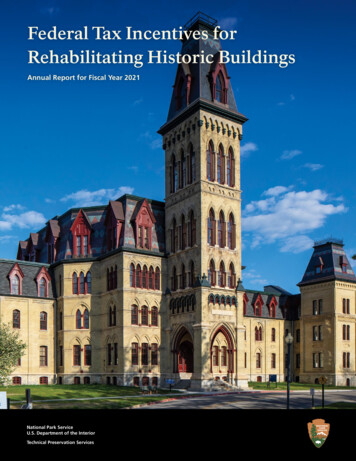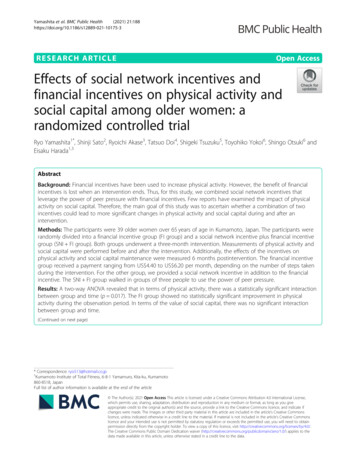
Transcription
Federal Tax Incentives forRehabilitating Historic BuildingsAnnual Report for Fiscal Year 2021National Park ServiceU.S. Department of the InteriorTechnical Preservation Services
Federal Tax Incentives for Rehabilitating Historic BuildingsA Successful Federal/State Partnership Since 1976The Federal Historic Preservation Tax Incentives Program, administered by the National Park Servicein partnership with the State Historic Preservation Offices, is the nation’s most effective program topromote historic preservation and community revitalization through historic rehabilitation. With over47,000 completed projects since its enactment in 1976, the program has leveraged over 116.34 billion inprivate investment in the rehabilitation of historic properties—spurring the reuse of historic structuresof every period, size, style, and type in all 50 states, the District of Columbia, Puerto Rico, and theU.S. Virgin Islands.Commonly known as the Historic Tax Credit, the program provides a 20% Federal tax credit toproperty owners who undertake a substantial rehabilitation of a historic building for a business orincome-producing use, while maintaining its historic character. In a three-part application process, theNational Park Service certifies that a building is historic, and therefore eligible for the program, and thatits rehabilitation meets Federal preservation standards.The Historic Tax Credit is the largest Federal program specifically supporting historic preservation.It generates much needed jobs and economic activity, enhances property values in older communities,creates affordable housing, and augments revenue for Federal, state, and local governments, leveragingmany times its cost in private expenditures on historic preservation. This widely-recognized programhas been instrumental in preserving the historic buildings and places that give our cities, towns, MainStreets, and rural areas their special character and has attracted new private investment to communitiessmall and large throughout the nation.Technical Preservation Services, National Park ServiceMarch 2022Residents’ lounge, OldMain Building (1867–1877),Northwestern Branch, NationalHome for Disabled VolunteerSoldiers, Milwaukee, WisconsinPhoto: Ryan Hainey Photography
Fiscal Year 2021 at a Glance1,2581,098Certifications ofsignificance (Part 1)Preliminary certificationsof rehabilitation (Part 2)Estimated rehabilitation costs. 7.75 billionMedian project QRE. 1.23 millionAverage project QRE. 7.06 millionOver 7.16 billion in private investment in historic preservationand community revitalization.Projects both big and small—almost half (47%) of allcompleted projects (Part 3) were under 1 million QREand 18% were under 250,000 QRE.New National Register nominations—about 15% of projectsinvolved properties not yet listed in the National Registerof Historic Places.Thirty-nine states have state historic tax credits thatcan be used in tandem with the Federal historic tax credit.1,063Certifications ofcompleted work (Part 3)FY 2021 Size of ProjectsEstimated rehabilitation costs . 7.16 billionMedian project QRE. 1.20 millionAverage project QRE. 6.74 million18%Under 250,00029% 25,000 to 999,999Rehabilitated housing units.4,94825% 1,000,000 to 4,999,999New housing units.11,29721% 5,000,000 to 24,999,999Low and moderate income housing units.7,2207%Over 25 millionQRE Qualified rehabilitation expendituresFY 1977 – FY 2021 Program Accomplishments 116.34 billion302,506Estimated Rehabilitation InvestmentRehabilitated Housing Units47,435Historic RehabilitationProjects Certified334,367New Housing Units185,525Low- and Moderate-IncomeHousing UnitsSource: Technical Preservation Services, National Park Service
2 Courtney Avenue (1900), now Heights House Airbnb, Newburgh,New York, before (left) and after (right) rehabilitationPhoto: Carolyn Coppola (left), Carter Peabody (right)George Miller Building (1838), now commercialand residential uses, Charleston, South CarolinaPhoto: Kendra Waters, MacRostieHistoric AdvisorsGeneva Car Barn & Powerhouse (1901), now SanFrancisco Parks & Recreation youth arts center,San Francisco, CaliforniaPhoto: Matthew Millman2021First National Bank Tower(1961), now The National,hotel, apartments, andcommercial uses,Dallas, TexasPhoto: Ron ShippPhotographyMontgomery Mill (1875-1920), now MontgomeryMill Apartments, Windsor Locks, ConnecticutPhoto: Crosskey ArchitectsGulfport-Harrison County Public Library(1966), now Coast Transit Authority GulfportTransit Center, Gulfport, MississippiPhoto: Katherine Anderson, MississippiDepartment of Archives & HistoryChurch of the Epiphany (right) and sanctuary (above),now Epiphany Center for the Arts, Chicago, IllinoisPhotos: John Cramer, MacRostie Historic Advisors (right),Tom MacDonald (above)
J. C. NewmanCigar Company(1910), continued use as acigar factory,Tampa, FloridaPhoto:Adria RebbecchiCoca-Cola Bottling Plant (left) and former Tasting Room (right) (1930–1951),now Bottleworks Hotel (left) and hotel lobby (right), Indianapolis, IndianaPhotos: Susan Fleck and Ratio DesignBeloit Water, Gas & Electric Company Powerhouse (below)and former Turbine Hall (right) (1908–1947), nowBeloit College Student Union, Beloit, WisconsinPhotos: Tom Harris and Studio GangOhringer Home Furniture (1941), now The Ohringer,artists’ residences, Braddock, PennsylvaniaPhoto: Robert KetchamKalispell Drug Company(1908), continued retailuse, Kalispell, MontanaPhoto: John HincheyScruton Block (1883), now commercial and residentialuses, Lewiston, MainePhoto: Scott T. Hanson, MacRostie Historic AdvisorsGolden Belt Manufacturing Company, Mill No. 1(c. 1900), now Golden Belt Campus, mixed usedevelopment, Durham, North CarolinaPhoto: LRC Properties and Alliance Architecture
Roof details, Old Main BuildingPhoto: Ryan Hainey PhotographyApartment, Old Main BuildingPhoto: Ryan Hainey PhotographyCOVER CASE STUDYNorthwestern Branch, National Home forDisabled Volunteer Soldiers MILWAUKEE , WISCONSINThe Northwestern Branch, National Home for Disabled VolunteerSoldiers—also known as the Milwaukee Soldiers Home—has beenreturned to its original purpose of housing and providing servicesfor veterans thanks to a 44 million rehabilitation project undertaken by The Alexander Company of Madison, Wisconsin.With eleven branches nationwide, the National Home for DisabledVolunteer Soldiers was created to house and provide medical carefor disabled Union troops after the Civil War. The NorthwesternBranch, opened in 1867, was particularly innovative, being thefirst to employ professional female nurses and to provide separatequarters for elderly veterans. The branches operated until 1930,when they were incorporated into the Veterans’ Administration.The Northwestern Branch is one of four branches designated as aNational Historic Landmark in 2011.for 20 years. Once again, the building and its iconic tower are theeye-catching centerpiece of the campus. The Headquarters Building(1895), the Catholic Chaplain’s Quarters (1909), and several Quartersbuildings (1916–1922) also were rehabilitated.Highlights of the rehabilitation work included careful treatment ofthe buildings’ exteriors and preservation of historic interior features and finishes throughout. Historic doors and windows, woodand terrazzo floors, metal ceilings, and tiled walls were preservedand repaired. Even historic post-office boxes were returned to theiroriginal use.As part of an Enhanced Use Lease agreement with the U.S. Department of Veterans Affairs, The Alexander Company preserved andrehabilitated six vacant historic buildings on the campus into 101supportive housing units for veterans and their families who arehomeless or at risk of becoming homeless. Residents have access toonsite services provided by the Milwaukee VA Medical Center.The Alexander Company partnered with the Housing Authorityof the City of Milwaukee and led a wide-ranging public-privatepartnership to preserve and reuse the historic buildings. Fundingsources included Federal low-income housing tax credits, Federaland State historic tax credits, and many other military and corporatefoundation funding sources. The Greater Milwaukee Foundation andthe Milwaukee Preservation Alliance organized a public fundraisingcampaign, Every Hero Deserves a Home, that attracted hundreds ofindividual donations. The project also received a Federal Save America’s Treasures grant through the National Park Service.When preservation efforts began in 2010, the fate of the campuswas so uncertain that it was listed as one of the 11 Most Endangered Historic Places in America by the National Trust for HistoricPreservation in 2011. The Victorian Gothic Old Main building(1867–1877), constructed of Milwaukee’s well-known Cream Citybrick and topped with a polychromatic slate roof, had been vacantThe rehabilitation of the six buildings has received many awards, including a 2021 Richard H. Driehaus Foundation National PreservationAward given by the National Trust for Historic Preservation, and the2021 ACHP/HUD Secretary’s Award for Excellence in Historic Preservation. It also provides a replicable model for preserving historic institutions and returning them to active service in their communities.
fy 2021 state-by-state project activityEstimated Qualified Rehabilitation Expenditures (QRE) and Five-Year Cumulative rict of kaNevadaNew HampshireNew JerseyNew MexicoNew YorkNorth CarolinaNorth DakotaOhioOklahomaOregonPennsylvaniaPuerto RicoRhode IslandSouth CarolinaSouth DakotaTennesseeTexasUtahVermontVirgin IslandsVirginiaWashingtonWest stimatedQRE at Part 2EstimatedQRE at ProjectCompletion(Part 3)Part 1 Part 2 Part 3 Part 1 Part 2 Part 3Cumulative TotalsFY 2017–FY 2021Part 3QRE161612121213 151,178,185 92,169,91749000000001 98Source: Technical Preservation Services, National Park Service1,063 7,749,574,494 7,162,274,5945,142 32,190,093,279
The Federal Historic Preservation Tax Incentives Programis administered by the National Park Service in partnership with the StateHistoric Preservation Offices.The State Historic Preservation Offices (SHPOs) are thefirst point of contact for property owners wishing to use the historicrehabilitation tax credit. The SHPOs can help determine whether a historicbuilding is eligible for Federal or State tax credits, provide guidance beforebeginning a project, and advise on the application requirements andappropriate preservation work. For the phone number or website of yourSHPO, contact the National Conference of State Historic PreservationOfficers at (202) 624-5465 or www.ncshpo.org.The Technical Preservation Services (TPS) office administersthe tax incentives program on behalf of the National Park Service.Information about the program and application requirements as welltechnical guidance and publications on preserving and rehabilitatinghistoric buildings is available from TPS at (202) 513-7270 orwww.nps.gov/tps.Front and Back Cover:Northwestern Branch, NationalHome for Disabled VolunteerSoldiers Milwaukee, WisconsinPhotos: Ryan HaineyPhotographyTop: Quarters Buildings (1916–1922), originallystaff housingMiddle: Original mailboxes in the Post Office,Headquarters BuildingBottom: Headquarters Building (1895–1896),originally administrative offices
Annual Report for Fiscal Year 2021 National Park Service U.S. Department of the Interior . Commonly known as the Historic Tax Credit, the program provides a 20% Federal tax credit to . (1966), now Coast Transit Authority Gulfport Transit Center, Gulfport, Mississippi Photo: Katherine Anderson, Mississippi .










